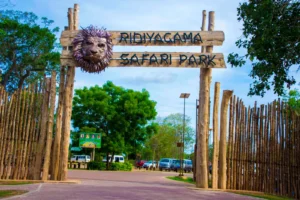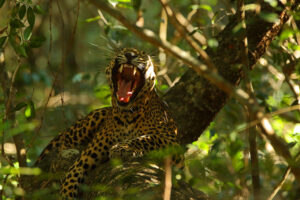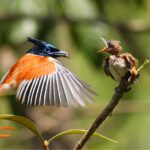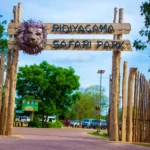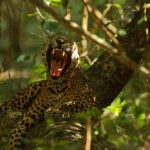Sinharaja rain forest trek is easily tops the best rainforest treks in Sri Lanka. The forest reserve is also the last remaining primary lowland rainforest in the island nation. The term Sinharaja is a closed compound word with the meaning “Lion king”. Perhaps, it was the last hideout of the now extinct Sri Lankan lion (Panthera leo sinhaleyus). In the present “lion-less” situation, Sinharaja rainforest is unique as an eco-system that is made up of a wide range of tropical flora and fauna. To elaborate, an astounding 64% of all endemic tree species recorded in Sri Lanka occur in this small patch of rainforest. A count of 19 out of 26 birds endemic to Sri Lanka occur here. Endemism among mammals and butterflies is greater than 50%. Some of the fascinating endemic fauna at Sinharaja are Sri Lanka wood pigeon (Columba torringtoni), green-billed Coucal (Centropus chlororrhynchus), Sri Lanka white-headed starling (Sturnus senex), Sri Lanka blue magpie (Cissa ornate), ashy-headed babbler (Garrulax cinereifrons), Sri Lanka broad-billed roller (Eurystomus orientalis irisi) and Sri Lankan leopard (Panthera pardus kotiya), Sri Lankan elephant (Elephas maxiumus Maximus) and endemic purple-faced Langur (Presbytis senex).
For Sri Lanka, the Sinharaja rain forest is an important protected area that is under the supervision of the Sri Lanka Department of wildlife conservation. It is a UNESCO world heritage site and also a UNESCO man and biosphere reserve as well. There are 22 villages surrounding the forest reserve which rely on the forest for various purposes. These villagers use many ancient footpaths that lead into the forest interior. Furthermore, Birdlife international has declared it as an important bird area (IBA) through their Sri Lankan arm FOGSL. Bird watchers who visit Sinharaja may be privileged to note a rare phenomenon identified as a bird wave. It is formally known as a mixed-species foraging flock. The Sinharaja Bird Wave is the biggest and the longest studied bird wave in the world. Even mammals are known to take part in Sinharaja bird waves when hundreds of different bird species flock together to literally sweep the forest for food.
Trek Information in Sinharaja Rain Forest
Sinharaja Opening and Closing Times – 6.30 a.m to 6.00 p.m
Sinharaja Forest Reserve Entrances
- Pitadeniya Entrances (Nearby Town – Mideripitiya)
- Kudawa Entrances (Nearby Town – Weddagala)
- Morning Side Entrances (Nearby Town – Rakwana)
Sinharaja Main Trails (Kudawa Entrance)
- Sinhagala Nature Trail
- Mulawella Nature Trail
Sinharaja Trek Duration – From 3 hours to 7 hours (Special bird walks can be arranged.)
Major eco-systems inside Sinharaja Forest Reserve
- Tropical Lowland Rain Forest
- Lowland Patana Grassland
- Rivers, streams and spray zones
Area in Sinharaja Forest Reserve
Total Area – 8,864 hectares
Other informations about Sinharaja Forest Reserve
- Status – Forest Reserve, UNESCO World Heritage Site, UNESCO Man and Biosphere Reserve, Important Bird Area (IBA), Virgin Rain Forest (Primary Rain Forest)
- Altitude – 300 metres to 1,170 metres
- Annual Rainfall Range – 3614mm – 5006mm
- Average temperature range – 190C – 340C
- Closest Towns to Sinharaja Forest Reserve – Deniyaya, Rakwana, Kalawana, Neluwa, Pelmadulla, Madampe
- Nearest Hospital to Sinharaja Forest Reserve – Deniyaya Base Hospital, Pothupitiya Divisional Hospital
Access Roads to Sinharaja Forest Reserve
- Colombo to Sinharaja via Pelawatta (138 km)
- Galle to Sinharaja via Akmeemana (79 km)
- Mirissa to Sinharaja via Akuressa (91 km)
- Tissamaharama (Yala) to Sinharaja via Middeniya (154 km)
- Bentota to Sinharaja via Pelawatta (85 km)
- Haputale to Sinharaja via Udawalawe (193 km)
- Kitulgala to Sinharaja via Ingiriya (172 km)
Major Attractions of Sinharaja Forest Reserve – Bird Waves, Endemic birdlife, Rainforest Trekking, Unique eco-system, Off the beaten track with low crowds, Endemic mammals, reptiles, amphibians, and flora
Best time to visit Sinharaja Forest Reserve – January to April and August to December
Useful Tips for Sinharaja Forest Reserve
- Wear good water proof hiking shoes.
- It’s mandatory to take an on-site naturalist with you.
- Wear leech socks and insect repellent.
- Take enough bottled water. Don’t forget to stay hydrated.
- Take care of yourself and others. Never get out of the footpath unless permitted by your naturalist. There are many reptiles in the undergrowth. Do not feed the animals inside the park. Remember that you are in the wild.


